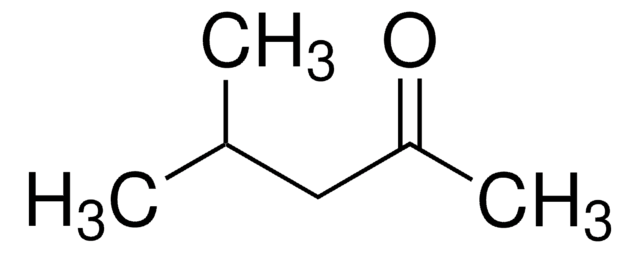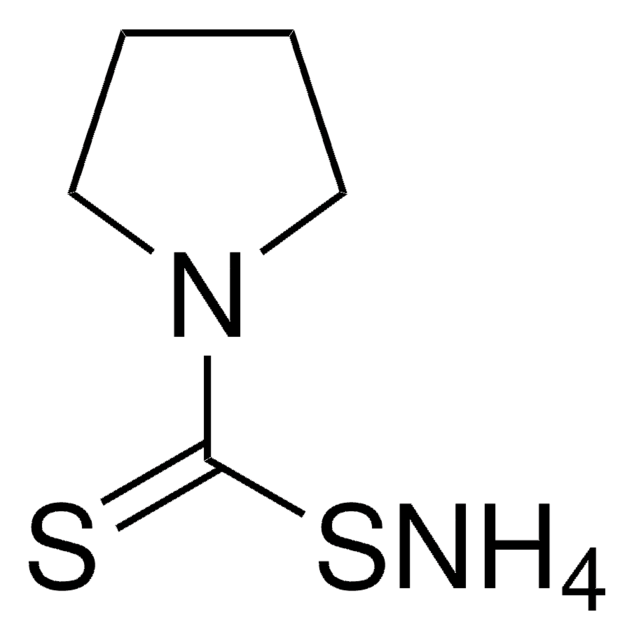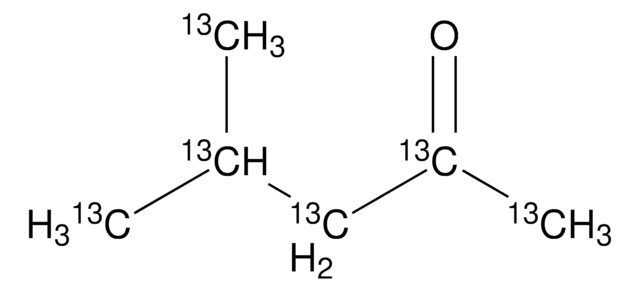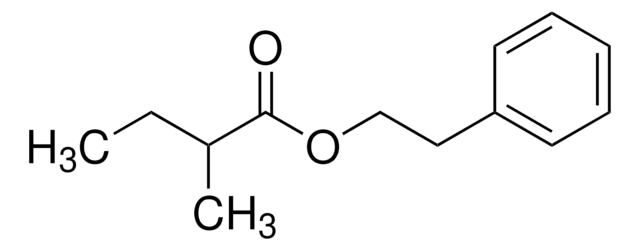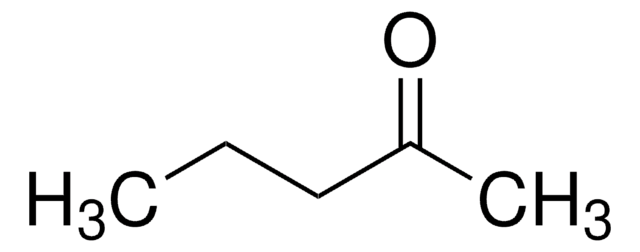W273104
4-Methyl-2-pentanone
≥99%, FCC
Synonym(s):
Isobutyl methyl ketone, Isopropylacetone, MIBK, Methyl isobutyl ketone
About This Item
Recommended Products
biological source
synthetic
grade
Kosher
Agency
meets purity specifications of JECFA
reg. compliance
FCC
FDA 21 CFR 117
FDA 21 CFR 172.515
vapor density
3.5 (vs air)
Assay
≥99%
form
liquid
autoignition temp.
840 °F
expl. lim.
1.2-8 %, 93 °F
refractive index
n20/D 1.395 (lit.)
bp
117-118 °C
mp
−80 °C (lit.)
density
0.801 g/mL at 25 °C (lit.)
application(s)
flavors and fragrances
Documentation
see Safety & Documentation for available documents
food allergen
no known allergens
Organoleptic
ethereal; fruity; spicy
SMILES string
CC(C)CC(C)=O
InChI
1S/C6H12O/c1-5(2)4-6(3)7/h5H,4H2,1-3H3
InChI key
NTIZESTWPVYFNL-UHFFFAOYSA-N
Looking for similar products? Visit Product Comparison Guide
Related Categories
General description
Application
- Thermodynamic Analysis of Eplerenone in 13 Pure Solvents at Temperatures from 283.15 to 323.15 K.: This study provides a detailed analysis of the solubility behavior and thermodynamics of Eplerenone, offering valuable insights for its application in solvent selection and pharmaceutical formulation (Liu et al., 2024).
- Development and validation of a high-throughput headspace solid-phase microextraction gas chromatography-mass spectrometry methodology for target and suspect determination of honey volatiles.: This article presents a method for the analysis of volatile compounds in honey, where 4-Methyl-2-pentanone is used to enhance the detection of aroma compounds critical for quality control and authenticity assessments (Gialouris et al., 2023). .
Disclaimer
Signal Word
Danger
Hazard Statements
Precautionary Statements
Hazard Classifications
Acute Tox. 4 Inhalation - Carc. 2 Inhalation - Eye Irrit. 2 - Flam. Liq. 2 - STOT SE 3
Target Organs
Central nervous system
Supplementary Hazards
Storage Class Code
3 - Flammable liquids
WGK
WGK 1
Flash Point(F)
57.2 °F - closed cup
Flash Point(C)
14 °C - closed cup
Personal Protective Equipment
Choose from one of the most recent versions:
Already Own This Product?
Find documentation for the products that you have recently purchased in the Document Library.
Customers Also Viewed
Global Trade Item Number
| SKU | GTIN |
|---|---|
| W273104-4KG | |
| W273104-4KG-K | 4061838108043 |
| W273104-SAMPLE | |
| W273104-SAMPLE-K | 4061837516245 |
| W273104-1KG | |
| W273104-1KG-K | 4061838249074 |
| W273104-8KG | |
| W273104-8KG-K | 4061838180940 |
Our team of scientists has experience in all areas of research including Life Science, Material Science, Chemical Synthesis, Chromatography, Analytical and many others.
Contact Technical Service